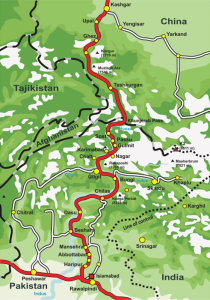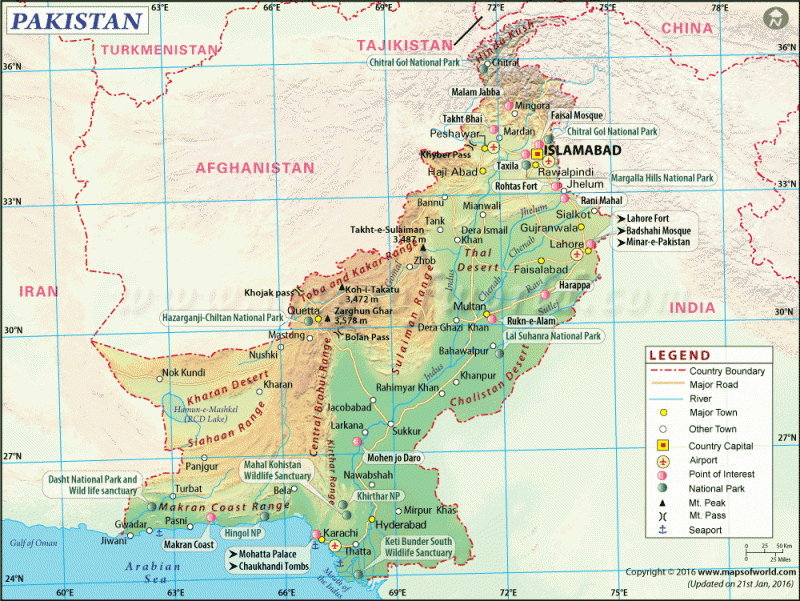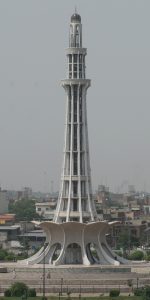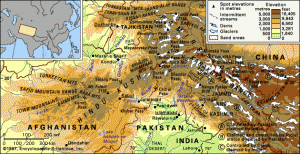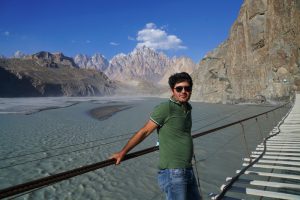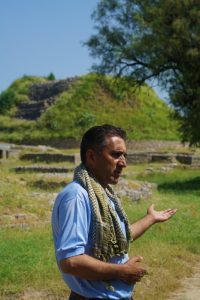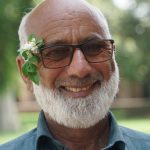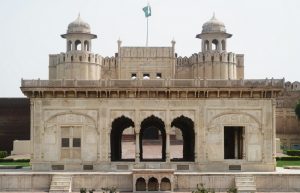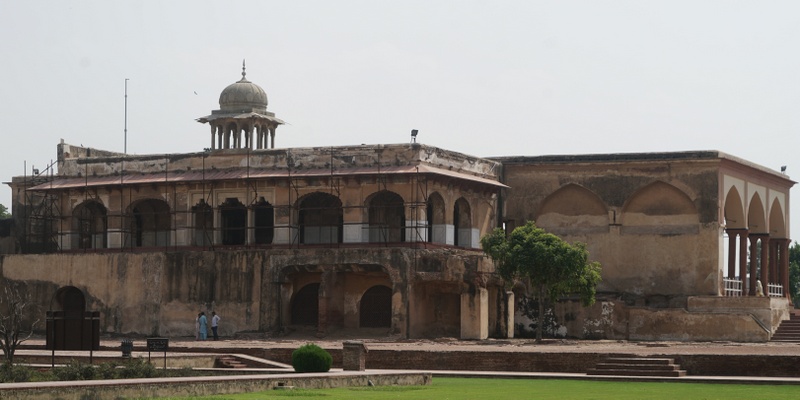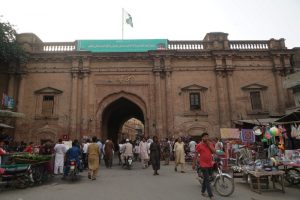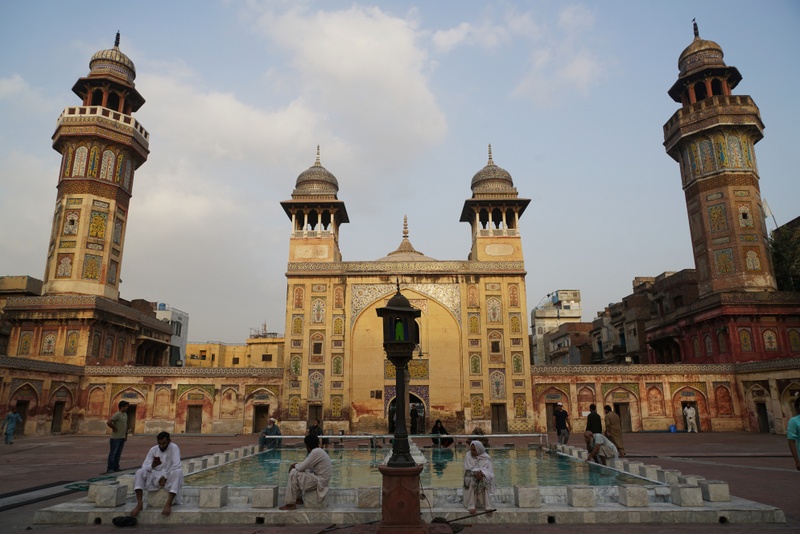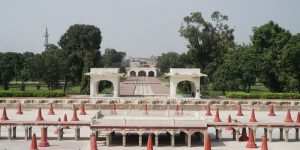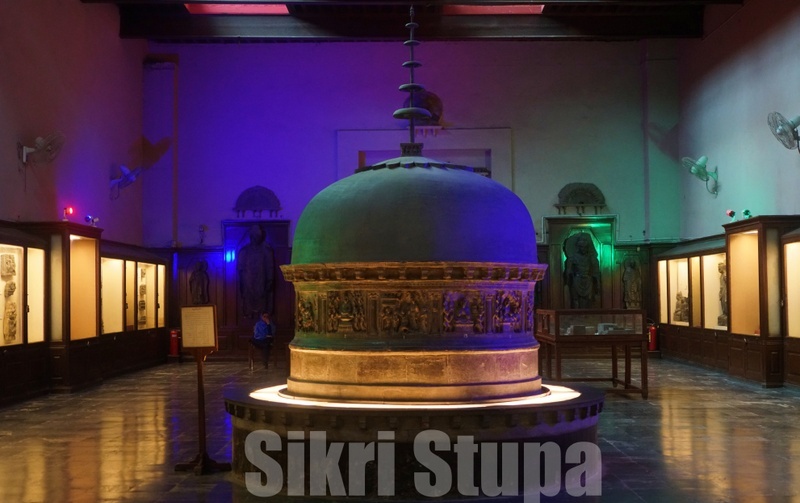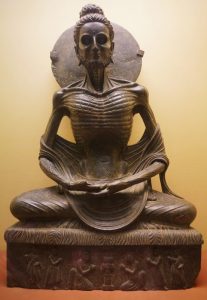Lahore & Rohtas Fort September 12 – 15, 2018

Rohtas Fort , a World Heritage Site. It was built by Pashtun king Sher Shah Suri between 1541 and 1548
I visited Karachi in the late 80s when Lawrence, my brother lived there. Pakistan has K2 (8,611m), the second highest peak in the world, stunning landscape, long history, amazing culture and people. My friend Brenda, a Tibetologist, has always been interested to visit the SWAT Valley which was an important centre of Buddhism from 1 century BC to about 8th century AD. We therefore decided to organise a small group to visit Pakistan and invite eight friends to join. Through Peggy, a friend who has been to Pakistan twice, we asked a local agent to arrange a 14-day trip from September 12 to 25 covering Lahore, the SWAT Valley and the Hunza Valley. One of the highlights is the Karakoram Highway (which has been described as the eighth wonder in the world) which links Kashgar, Xinjiang China to Islamabad, Pakistan. The origin plan for the group was to end the trip in Kashgar.
As Tajikistan has long been on my list and is easily accessible from Tashkurgan, Xinjiang China, I suggested the group travel with me to Tajikistan and fly back to Hong Kong on October 1 from Dushanbe, capital of Tajikistan via Astana, Kazakhstan. After my friends’ departure, I would explore the northern part of Tajikistan before spending three weeks in Xinjiang, Gansu and Ningxia, the three western autonomous regions in China.
Travel Mates
I am often a solo traveller. But this time, I would be travelling with four groups of friends and would be on my own only for four days (October 8 to 11). First, I would travel with Brenda, Flora, Karen, Kylie, Ophelia, Joy and Sunny and WH from Lahore to Dushanbe. Next, I would explore northern Tajikistan with Kylie. Then I would travel with seven Hong Kong friends from Dunhuang to Zhangye in China. For the last leg from Zhangye to Yinchuan, I would be with Bing.
Pakistan
Pakistan is the world’s sixth-most populous country with a population of 207 million (2017 census). Bordering India to the east, Afghanistan to the west, Iran to the southwest and China in the far Northeast and separated narrowly from Afghanistan’s Wakhan Corridor in the northwest, Pakistan has an area of 881,913km² and a coastline of over 1000km along the Arabian Sea and Gulf of Oman.
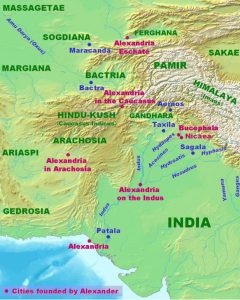 Many ancient cultures had developed in the territory of the present- day Pakistan. They include the Mehrgarh of the Neolithic and the Bronze Age Indus Valley civilisation. The area has been ruled and part of the empire of the Persian Achaemenid (c. 550-330 BC), Alexander III of Macedon (336 -323 BC), the Seleucid (312 – 63 BC), the Indian Maurya (321 – 187 BC) and Gupta (mid to late 3rd century AD to 590 AD), the Arab Umayyad Caliphate (611 – 744), the Delhi Sultanate (1206 – 1526), the Mongol (13th -14th centuries), the Mughal (1526-1540; 1555-1857), the Afghan Durrani (1747-1826), the Sikh (1799 – 1849) and the British (1849 – 1947).
Many ancient cultures had developed in the territory of the present- day Pakistan. They include the Mehrgarh of the Neolithic and the Bronze Age Indus Valley civilisation. The area has been ruled and part of the empire of the Persian Achaemenid (c. 550-330 BC), Alexander III of Macedon (336 -323 BC), the Seleucid (312 – 63 BC), the Indian Maurya (321 – 187 BC) and Gupta (mid to late 3rd century AD to 590 AD), the Arab Umayyad Caliphate (611 – 744), the Delhi Sultanate (1206 – 1526), the Mongol (13th -14th centuries), the Mughal (1526-1540; 1555-1857), the Afghan Durrani (1747-1826), the Sikh (1799 – 1849) and the British (1849 – 1947).
Pakistan is the only country to have been created in the name of Islam. Muhammad Ali Jinnah led the Pakistan Movement in the Indian subcontinent’s struggle for independence from the British and Pakistan was created in 1947 as an independent homeland for Indian Muslims. Following an ethnic civil war in 1971, East Pakistan broke away and became a new country of Bangladesh. It has continued conflicts with India over disputed territory in Kashmir. Today, it is a nuclear power and has the world’s sixth-largest standing armed forces.
Pakistan adopted a new constitution in 1973 and established a federal government in Islamabad with four provinces (Punjab, Khyber Pakhtunkhwa, Sindh and Balochistan and three federal territories (Islamabad Capital Territory, Gilgit-Baltistan, and Azad Kashmir).
Pakistan is divided into eight geographic areas namely the northern highlands; the Indus River plain, the Desert areas, the Pothohar Plateau and Balochistan Plateau and Salt Range, and the Sistan Basin. All the rivers of Pakistan i.e. Sindh, Ravi River, Chenab River, Jhelum River, the Sutlej River originate from the Himalayas mountain range. Northern, northeast and northwest Pakistan have a most dramatic and complex landscape formed by three mountain ranges, namely Karakoram, Himalayas and Hindu Kush. Gilgit-Baltistan has five of the ”eight – thousanders” and more than 50 peaks above 7,000m. Three of the world’s longest glaciers outside the polar regions are found in this region.
Pakistan’s state religion is Sunni Islam. Over 96% of the population are Muslim. But it is an ethnically and linguistically diverse country. About 45% of the population are Punjabis, 15.4% Pashtuns, 14.1% Sindhis, 8.4% Saraikis and 7.6% Muhajirs. Some 60 languages are spoken in the country.
Pakistan has been battling since independence with political instability, corruption, illiteracy, overpopulation and terrorism. It is still considered a developing country with a semi-industrialised economy with centres of growth along the Indus River. Given its diverse cultures, people and landscapes, the country has rich tourism resources including six World Heritage Sites. They are the Buddhist ruins of Takht-i-Bahi and Neighbouring City Remains at Sahr-i-Bahol and Taxila; Fort and Shalamar Gardens in Lahore, Rohtas Fort; Historical Monuments at Makli and Archaeological Ruins at Moenjodaro. The first four sites are in north while the last two in the south.
As of 2016, Pakistan’s estimated nominal GDP is US$271 billion (nominal per capita GDP US$1,561) but the GDP by PPP is US$946,667 million (GDP(PPP)/capita US$5,010). While the country has an estimated 40 million middle class citizens, a fifth of the population also lives below the international poverty line of US$1.25 a day.
Day 1 September 12 Wednesday: Hong Kong (GMT+8) – Lahore, Pakistan (GMT+5)
We took Thai Airways which has a direct flight to Lahore from Bangkok. We gathered at the airport before noon. At the check-in counter, I was asked to produce my visa for Pakistan. I also showed my Home Permit to China as I would leave Pakistan for China by road. The lady then asked my destination after China. I said “Tajikistan”. She insisted on a printed copy of my e-visa. As a result, I had to go to a baggage office and paid HK$20 for a coloured printed copy. A rip-off! I cannot understand the justification for requiring me to show my e-visa.
While we were having lunch, Brenda suddenly felt dizzy and had to lay her head on the table. We asked for a wheel-chair. But there was none. She managed to get to the gate. The airline staff were concerned and tried to persuade her not to board the plane. Anything, her dizziness had gone and she got on the plane.
We had a short flight to Bangkok where we spent four hours at the airport. Most of us have Priority Pass and can use the lounge for free. The food and ambience of the lounge are nice.
The 4-hour flight to Lahore took off on schedule after 8pm (local time) and we arrived in Lahore after 10pm (local time). The immigration and luggage services are much better than those at the Delhi airport. It was about 11am when we came out and were greeted by Saaz of Asian Gateways and Karim, our guide and Cha Cha (meaning uncle).
Unfortunately, the traffic management at the airport was awful: our 22-seat minibus was stuck for almost half an hour before we could pay and leave the car park. It was after midnight when we checked in PC Continental Hotel where we would stay three nights. Flora was room-mate. It was well after 2 am when I laid down in a comfortable bed. What a long and tiring day!
Day 2 September 13 Thursday: Lahore
Lahore is the capital city of the province of Punjab, the second most populous city (with an estimated population of 11 million) after Karachi, the historic cultural centre of the Punjab region and one of Pakistan’s wealthiest cities. The city has been controlled by various empires and reached its zenith under the Mughal Empire between the late 16th and early 18th centuries. It was the capital of the Sikh Empire and late the British Punjab. It was central to the independence movements of both India and Pakistan with the city being the site of both the declaration of Indian Independence and the resolution calling for the establishment of Pakistan.
We had a good rest and did not set off till 10 am. We spent the whole morning in the Badshahi Mosque and Lahore Fort in old Lahore. Based on their previous experience with Mainland China visitors, Saaz and Karim expected the morning sightseeing programme be over around 12:30 pm followed by lunch. Soon, they realised that we were a special and inquisitive group with few scholars and many keen photographers. We care more about sightseeing than food. As a result, we did not finish the visit till 1:30 pm.
Badshahi Mosque commissioned by Aurangzeb, the sixth Mughal emperor in 1671 and completed in 1673, was the largest in the world for 313 years. The mosque built to commemorate military campaigns against Maratha king Chhatrapati Shivaji, was a symbol of the Mughal power. After the fall of the empire, it was used as a garrison by the Sikh and British Empires.
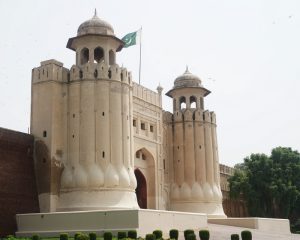
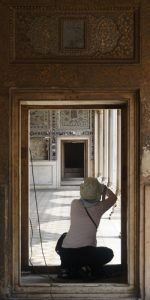 The red sandstone mosque complex is majestic. The entrance to the mosque complex is via a two-storey edifice. Its gateway faces east towards the Alamgiri Gate of the Lahore Fort. The massive courtyard can accommodate 100,000 worshippers. The mosque has three domes and the prayer hall has a central arched niche with five niches flanking it. Both its interior and exterior are decorated with elaborate white marble carved with floral designs. The four minarets at each corner are 60m tall.
The red sandstone mosque complex is majestic. The entrance to the mosque complex is via a two-storey edifice. Its gateway faces east towards the Alamgiri Gate of the Lahore Fort. The massive courtyard can accommodate 100,000 worshippers. The mosque has three domes and the prayer hall has a central arched niche with five niches flanking it. Both its interior and exterior are decorated with elaborate white marble carved with floral designs. The four minarets at each corner are 60m tall.
The Lahore Fort is a World Heritage Site owing to its “outstanding repertoire” of Mughal monuments dating from the era when the empire was at its artistic and aesthetic zenith. The first fortified mud-brick fort can be traced to the 11th century. The foundation of the modern fort dates to 1566 during the reign of Emperor Akbar. Today’s citadel / fort divided into the administrative section and a private residential section and spreading over 20 hectares, was constructed by different Mughal emperors. After the fall of the empire, Ranjit Singh, founder of the Sikh Empire used it as his residence.
The citadel contains 21 notable monuments many of which were built by Shah Jahan. The fort’s grand and iconic Alamgiri gate was constructed by Emperor Aurangzeb. We entered through the Elephant Gate and mainly spent our time in the residential section of the citadel.
In the Shah Burj Quadrangle, we saw the Naulakha Pavilion (1633) which derives its name from the Urdu word for 900,000, Naulakha. Next, we saw the “Picture Wall” constructed by Emperor Jahangir and completed during the reign of his son, Shah Jahan. The wall is exquisitely decorated with vibrant array of glazed tile, faience mosaics and frescoes.
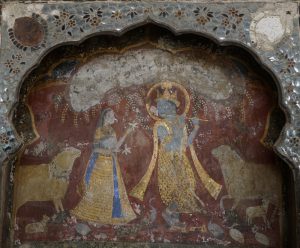
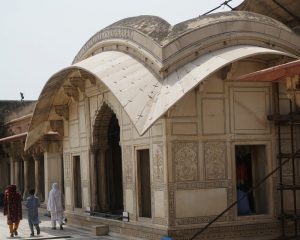 The place we enjoyed most is the Sheesh Mahal (The Palace of Mirrors) constructed by Shah Jahan in 1631-32. The white marble pavilion’s wall is inlaid with pietra dura and complex mirror-work (known as ayina kari). I have seen many mirror halls and find this most stunning and romantic.
The place we enjoyed most is the Sheesh Mahal (The Palace of Mirrors) constructed by Shah Jahan in 1631-32. The white marble pavilion’s wall is inlaid with pietra dura and complex mirror-work (known as ayina kari). I have seen many mirror halls and find this most stunning and romantic.
Located directly beneath the Sheesh Mahal and Shah Burj quadrangle is the Summer Palace. The chambers were cooled by effective ventilation systems that channelled cool breezes into the palace which contained an elaborate system of 42 waterfalls and cascades.
The Khilwat Khana (1633) built by Shah Jahan, was the residence of the royal ladies of the court.
The Kala Burj (Black Pavilion) and the Lal Burj (Red Pavilion) used as summer pavilions were built by Jahangir. Its paintings were in European-influenced style.
Finally, we passed by the Diwan-i-Khas, a hall where the Emperor attended to the state affairs and receive courtiers and guests.
The fort is expansive and historical. We have seen less than half of all the notable monuments.
Saaz and Karim picked a nice middle-east restaurant located on the other side of the city. As a result, we wasted over half an hour in traffic jam and did not have lunch till 2:30 pm. (If I had a choice, I would rather have lunch in the Food Street close by so that we could have spent 30 minutes more in the fort). Anyway, we enjoyed our first buffet lunch with plenty of choices. Around 3:30 pm, we boarded the bus heading back to the Walled City of Lahore.
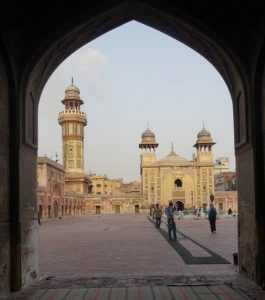 We got off outside the Delhi Gate and strolled through the Wazir Khan Chowk (bazaar) to visit the Wazir Khan Mosque (1634-1641). Commissioned by Wazir Khan, the chief physician to the Mughal court, who later became Viceroy of Punjab, this small mosque measuring 85m by 48m is renowned for its intricate faience tile work and its interior surfaces that are almost entirely embellished with elaborate Mughal-era frescoes.
We got off outside the Delhi Gate and strolled through the Wazir Khan Chowk (bazaar) to visit the Wazir Khan Mosque (1634-1641). Commissioned by Wazir Khan, the chief physician to the Mughal court, who later became Viceroy of Punjab, this small mosque measuring 85m by 48m is renowned for its intricate faience tile work and its interior surfaces that are almost entirely embellished with elaborate Mughal-era frescoes.
The entrance through a large Timurid-style Iwan over a small portal is colourful and beautiful. The courtyard is flanked on four sides by 32 khanas (small study cloisters for religious scholars). In the middle is a pool for ritual washing. There is also a tomb of the 14th century Sufi saint Syed Muhammad Ishaq Gazruni. The prayer hall is divided into five sections aligned into a single aisle running north to south. The central section is topped by a 10m tall dome with a diameter of 7m resting upon four arches that form a square pavilion.
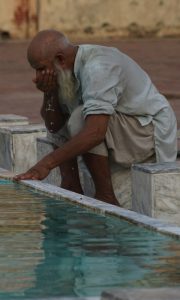 I climbed one of the four 32m-high minarets to the top for a panoramic view. The sun was setting over the atmospheric old city.
I climbed one of the four 32m-high minarets to the top for a panoramic view. The sun was setting over the atmospheric old city.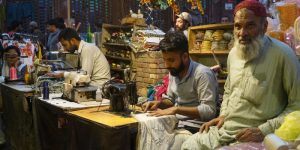
It was dark when we left the mosque. Karim took us through the bazaar and planned to depart for dinner around 6: 30 pm from the Delhi Gate. The bazaar sprang to life: it was crowded and lively. When the group was about to leave, Saaz and Karim discovered that Karen was missing. What had happened? Karim and Saaz were anxious. Eight of us stayed as a group while they went to find her. Saaz asked shop-keepers who told him Karen had gone in the opposite direction. We were all relieved to see Karen again. What a scaring experience for Karen, our guides and the group.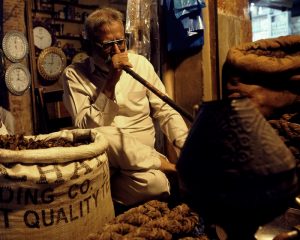
We had an authentic Chinese dinner in a home-restaurant located in a nice residential area. To the surprises of our host, we ordered mostly cheap vegetable dishes. We have difficulties in explaining to them that we prefer light dishes cooked without much oil and salt. We remind them to order few dishes as we do not eat much and hate to waste food. They find our behaviours strange: we are different from the Mainland Chinese tourists they have encountered.
Day 3 September 14 Friday: Lahore
The original plan was to begin the day with a visit to the National Museum. But it was closed. We therefore spent the morning in the Jahangir’s Tomb and Shalimar Gardens.
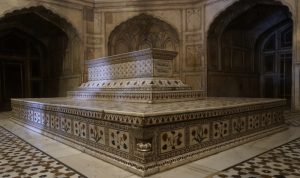
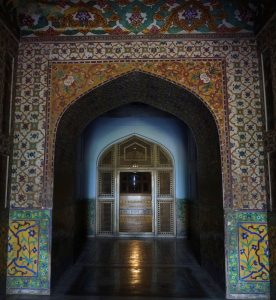 Jahangir’s Tomb, the mausoleum built for Mughal Emperor Jahangir (1569 – 1627), is famous for its interior that is richly embellished with frescoes and marbles. Located across the River Ravi, the mausoleum was constructed in Mughal style influenced by Safavid-style architecture from Persia.
Jahangir’s Tomb, the mausoleum built for Mughal Emperor Jahangir (1569 – 1627), is famous for its interior that is richly embellished with frescoes and marbles. Located across the River Ravi, the mausoleum was constructed in Mughal style influenced by Safavid-style architecture from Persia.
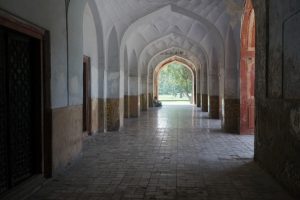 The façade is embellished with red sandstone inlaid with marble motifs. Its exterior of the mausoleum is richly decorated with pietra dura. At its centre is an octagonal chamber lined with carved marble. The remains of the emperor rest in a crypt below a cenotaph inlaid with pietra dura in vegetal patterns and the 99 Names of Allah. Four octagonal ornamental minarets were built at each corner.
The façade is embellished with red sandstone inlaid with marble motifs. Its exterior of the mausoleum is richly decorated with pietra dura. At its centre is an octagonal chamber lined with carved marble. The remains of the emperor rest in a crypt below a cenotaph inlaid with pietra dura in vegetal patterns and the 99 Names of Allah. Four octagonal ornamental minarets were built at each corner.
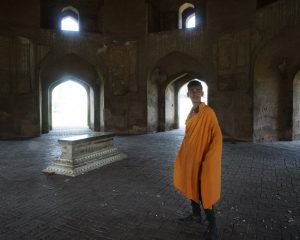 Nearby is the tomb of Asif Khan (c. 1569 – 1641), brother of Nur Jahan, and brother-in-law to Emperor Jahangir. But it is in poor condition.
Nearby is the tomb of Asif Khan (c. 1569 – 1641), brother of Nur Jahan, and brother-in-law to Emperor Jahangir. But it is in poor condition.
Shalimar Gardens built in1641-42 by Shah Jahan, was laid out as a Persian paradise garden. It was declared a World Heritage Site as they embody Mughal garden design at the apogee of its development.
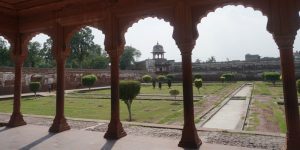 The gardens laid out in the form of a rectangle aligned along a north-south axis measuring 658m by 258m covering an area of 16 hectares. There are three terrace level each being 4-5m higher than the previous level. The highest terrace was reserved for the Emperor’s harem and the middle one was the Emperor’s Garden.
The gardens laid out in the form of a rectangle aligned along a north-south axis measuring 658m by 258m covering an area of 16 hectares. There are three terrace level each being 4-5m higher than the previous level. The highest terrace was reserved for the Emperor’s harem and the middle one was the Emperor’s Garden.
The gardens contained the most elaborate waterworks of any Mughal garden with five water cascades and 410 fountains (105, 152 and 153 in the upper, middle and lower terraces respectively). There are also numerous buildings, pavilions, sleeping chambers etc. Many types of trees including fruit trees are growing in the garden.
It was a hot day. The fountains were drained owing to the problem of dengue fever. I find the place bleak, depleted and dilapidated and not impressive. Why was it listed as a World Heritage Site in 1981?
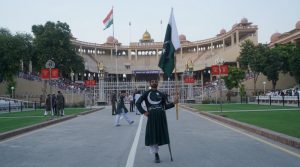 At lunch, we were served with chicken karahee, mutton karahee, mix vegetable, fried rice and biryani. We had the same dishes most of the days. After lunch, we drove 24 km to the Wagah border to watch the flag lowering ceremony (essentially a Beating Retreat) which has taken place since 1959.
At lunch, we were served with chicken karahee, mutton karahee, mix vegetable, fried rice and biryani. We had the same dishes most of the days. After lunch, we drove 24 km to the Wagah border to watch the flag lowering ceremony (essentially a Beating Retreat) which has taken place since 1959.
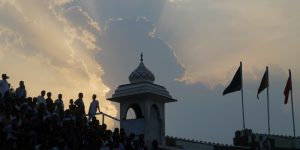 We arrived around 4:30 pm. There are stadium-like seating arenas on both side of the borders. The Pakistani side is much smaller as India is six times more populous. We were surrounded by enthusiastic Pakistanis. A couple of soldiers performed to keep the crowd amused: the excited crowd broke out into uproars chanting “Allah” and “Long Live Pakistan” from time to time. But we could not hear the sounds on the Indian side. The crowd looked unenthusiastic and I did not see people chanting and standing up.
We arrived around 4:30 pm. There are stadium-like seating arenas on both side of the borders. The Pakistani side is much smaller as India is six times more populous. We were surrounded by enthusiastic Pakistanis. A couple of soldiers performed to keep the crowd amused: the excited crowd broke out into uproars chanting “Allah” and “Long Live Pakistan” from time to time. But we could not hear the sounds on the Indian side. The crowd looked unenthusiastic and I did not see people chanting and standing up.
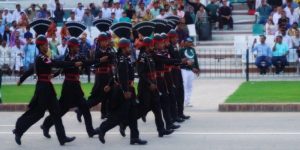
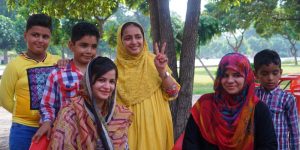 The daily military practice/ceremony conducted by the Pakistan Rangers and Indian Border Security Force, is characterised by elaborate and rapid dance-like manoeuvres and raising legs as high as possible. It is taken as a symbol of the two countries’ rivalry, as well as brotherhood and cooperation between the two nations. The ceremony starts with a blustering parade by the soldiers from both sides and ends with a perfectly coordinated lowering of the flags which are neatly folded, a retreat that involves a brusque hand shake between soldiers from either side and the closing of the gates.
The daily military practice/ceremony conducted by the Pakistan Rangers and Indian Border Security Force, is characterised by elaborate and rapid dance-like manoeuvres and raising legs as high as possible. It is taken as a symbol of the two countries’ rivalry, as well as brotherhood and cooperation between the two nations. The ceremony starts with a blustering parade by the soldiers from both sides and ends with a perfectly coordinated lowering of the flags which are neatly folded, a retreat that involves a brusque hand shake between soldiers from either side and the closing of the gates.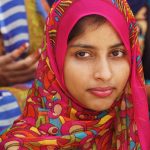
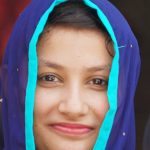 Pakistanis seem patriotic and enthusiastic. I am impressed by the Pakistani soldiers who are all tall, fit and handsomely dressed. The Indian force and spectators paled in comparison.
Pakistanis seem patriotic and enthusiastic. I am impressed by the Pakistani soldiers who are all tall, fit and handsomely dressed. The Indian force and spectators paled in comparison.
After looking up some travel guides, I proposed dinner in the Food Street next to the Mosque. It worked out well: we had a nice meal while enjoying the lit-up Mosque and Lahore Fort.
Day 4 September 15 Saturday: Lahore – Rawalpindi/Islamabad 370km
We spent an hour in the Lahore Museum founded in 1865 and renowned for its extensive collection of Buddhist art from the ancient Indo-Greek and Gandhara kingdoms. The Fasting Buddha dating from the Gandhara period, is one of the museum most prized and celebrated objects.
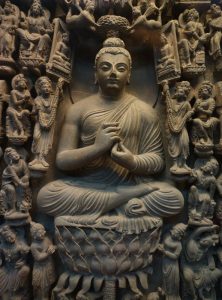 It also contains some fine specimens of Mughal and Sikh carved woodwork and a large collection of paintings dating back to the British period. I find the building impressive but the lighting and information on the exhibits far from satisfaction.
It also contains some fine specimens of Mughal and Sikh carved woodwork and a large collection of paintings dating back to the British period. I find the building impressive but the lighting and information on the exhibits far from satisfaction.
As we had a long way to go, we moved on at 10 am taking the Grand Trunk Road to Rohtas Fort. We stopped by the Jhelum River for lunch and arrived at our destination at 3:30 pm.
Rohtas Fort, occupying a strategic position between the mountain region of Afghanistan and the plains of Punjab, was built by Pashtun king Sher Shah Suri between 1541 and 1548. It was built to prevent the Mughal emperor Humayun who was in exile in Persia from returning to India and to help subdue the rebellious tribes of the Potohar region in northern Punjab that were loyal to the Mughal crown.
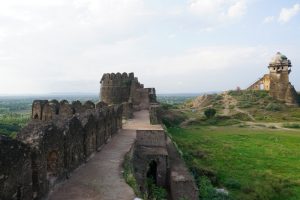
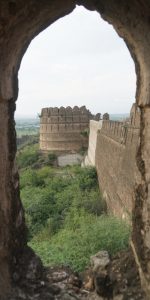 The fort that could hold a force of up to 30,000 men, covers an area of 70 hectares, enclosed by 4 kilometres of walls that were bolstered by 68 bastion towers and 12 gates. Being one of the largest and most formidable in the subcontinent, the fort was inscribed on the World Heritage List for being an “exceptional example of the Muslim military architecture of Central and South Asia”.
The fort that could hold a force of up to 30,000 men, covers an area of 70 hectares, enclosed by 4 kilometres of walls that were bolstered by 68 bastion towers and 12 gates. Being one of the largest and most formidable in the subcontinent, the fort was inscribed on the World Heritage List for being an “exceptional example of the Muslim military architecture of Central and South Asia”.
We spent two hours in this expansive fort. There are no palaces except for the Raja Man Singh Haveli built on the highest point of the citadel. We followed a local guide and walked to this one-storey ruin that offers an excellent panoramic view of the fort and surrounding area.
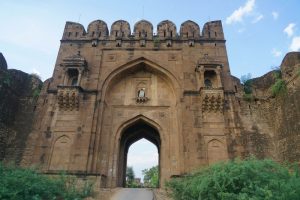 Next, we went to the ramparts built following the hilltop’s contour. We climbed and walked along the wall which height varies between 10 and 18 metres with a thickness between 10 and 13 metres. The wall was built in sandstone laid in lime mortar mixed with brick.
Next, we went to the ramparts built following the hilltop’s contour. We climbed and walked along the wall which height varies between 10 and 18 metres with a thickness between 10 and 13 metres. The wall was built in sandstone laid in lime mortar mixed with brick.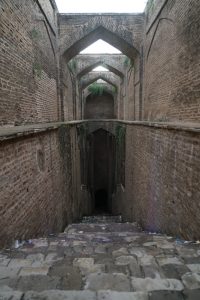
We had a short ride to the Sohail Gate which was likely the ceremonial main entrance to the fort. Measuring 21.34m high, 20,73m wide and a depth of 15m, it features some of the best masonry work of the Sur Empire. The balcony designs are derived from Hindu rather than Afghan-Persian architecture.
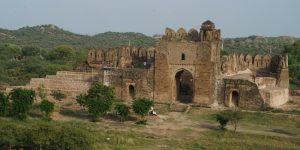 Before leaving, we walked to the Central Baoli, one of the three stepwells made by cutting deep into the lime rock. This baoli has 148 steps and was once used for soldiers, elephants and horses etc.
Before leaving, we walked to the Central Baoli, one of the three stepwells made by cutting deep into the lime rock. This baoli has 148 steps and was once used for soldiers, elephants and horses etc.
We left the fort at 5:30 pm and arrived at PC Hotel in Rawalpindi before 7 pm. Sadru, boss of Asian Gateways and elder brother of Saaz, was already waiting for us at the lobby. We had dinner in Tai Pan Restaurant in the hotel. I have never had such bad Chinese food in a Chinese restaurant in a five-star hotel.


